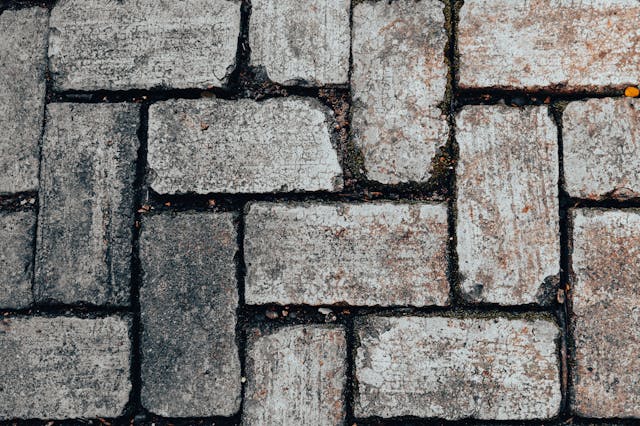
How to fix a loose paving slab
Across the trade, the consensus is clear that quick surface fixes rarely hold. Left alone, a loose paving slab can trap water and accelerate damage to the rest of your patio.
The dependable remedy is to re-bed the slab fully on mortar (typically around a four-to-one sharp sand to cement mix) so there are no voids beneath, and to reinstate the joints once the bed has cured.
The good news is that learning how to fix a loose paving slab is relatively easy. Below, we walk you through the steps you can take using simple tools and a realistic weekend timeline.
What causes loose paving slabs?
Typically, loose slabs result from a breakdown in support or bonding beneath the stone.
Some common culprits include inadequate or uneven sub-base, pavers disturbed before the mortar cured, water getting into joints and beds, and freeze–thaw cycles that weaken the bond. Before you learn how to fix a loose paving slab, you need to know why it happens:
Weather damage
In the UK, paving slabs are no strangers to repeated wet spells and winter freezes. Water penetrates the surface of the paving, and when temperatures drop, it freezes and expands. It then breaks down jointing and mortar, which gradually loosens the slab.
When the ice thaws, the water can seep deeper into the material, ready for the next freeze cycle, and on it goes.
Heavy loads
Excessive weight and traffic can cause paving slabs to loosen, even on domestic patios.
If the sub-base is too thin or poorly compacted, loads from foot traffic, furniture, barbecues or vehicles concentrate on weak spots and lead to wobbly slabs. Heavy impacts can also lead to cracking, especially if the base or mortar bed is insufficient.
Soil shifting
Even well-laid paving can loosen if the ground beneath moves.
Heavy rainfall or poor drainage can cause the ground beneath the paving to settle and move. Plus, slabs are laid directly on soil or on an inadequate base are prone to shift and sink over time as the underlying material washes out.
Bad installation technique
The fastest route to a wobbly patio is cutting corners at the start.
A very common reason for loose slabs is an insufficient base, meaning there isn't enough compacted sub-base to prevent ground movement. If the sub-base is not deep enough, slabs are more likely to shift.
Loose slabs usually need lifting, cleaning out and re-bedding on a proper full mortar bed.
How to fix loose paving slabs: step-by-step instructions
Before getting started, check the weather: are conditions dry (and will they stay that way for several hours?) Is there any chance slabs will freeze overnight? Most importantly, do you have protective gear, like gloves, goggles and kneepads?
1. Remove jointing
Chisel out all the old mortar or jointing around the loose slab, carefully working the edges with a plug chisel or bolster hammer. Clear the joints fully, so the slab can be freed without damaging adjacent slabs.
Remove loose debris and dust to clean the joints.
2. Carefully lift slab
Once the joints are cleared, use a spade or pry bar along with a timber offcut to protect the neighbouring slabs and lever the slab up.
For larger or heavier slabs, enlist help to avoid cracking (or injury), rolling or sliding the slab gently out of its place once loosened.
3. Remove old mortar
Chisel away all old bedding mortar beneath the slab until you reach a firm, even base. Check the underlying sub-base for stability; if it is soft, uneven or eroded, remove and replace or top up and compact it so it provides solid, level support.
4. Relay slab
Create a new mortar bed using a mix of sharp sand and cement, typically with a ratio of four parts sharp sand to one part cement.
Moisten the back side of the slab slightly and then carefully place it into the mortar bed so that the underside of the slab is fully in contact with no voids.
Tap it into position so it is level and flush with surrounding slabs. As the mortar sets, refill the joints using the same sand-and-cement mix (or a suitable pointing compound).
Then, leave the repair undisturbed until the bedding and jointing have fully cured.
Shop with Ovation Landscaping for high-quality paving slabs!
Ready to sort that wobbly slab? Shop with Ovation Landscaping for high-quality paving slabs. Browse our impressive collections of paving porcelain and natural stone, which include R11 slip-resistant options perfect for British patios and pools.
If you’re in need of something extra tough, shop our durable concrete flags in practical thicknesses for heavy-use spaces, then get everything delivered to your door with Ovation Landscaping’s UK-wide pallet service.